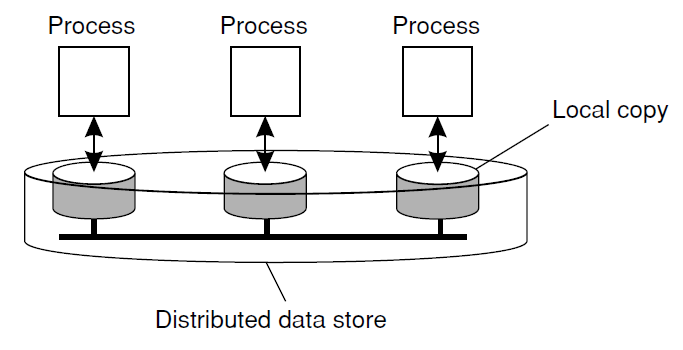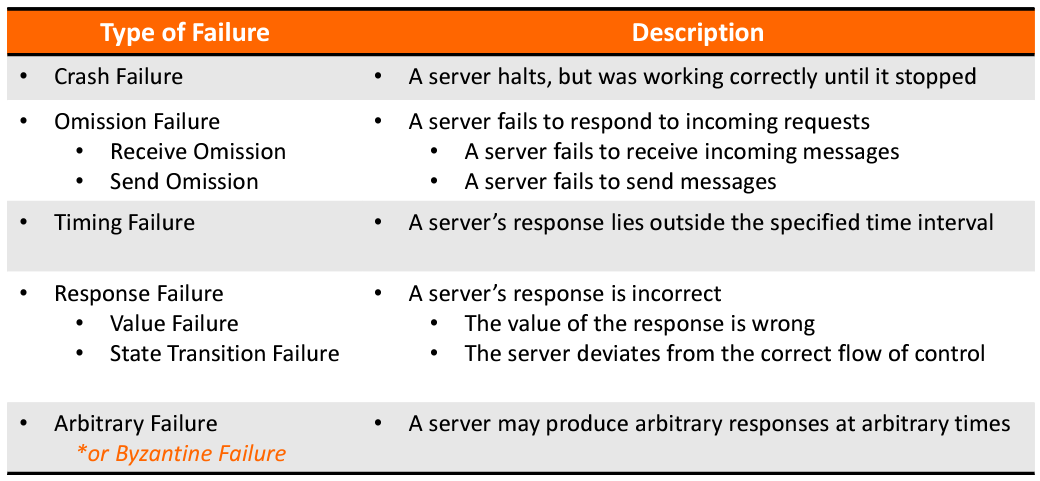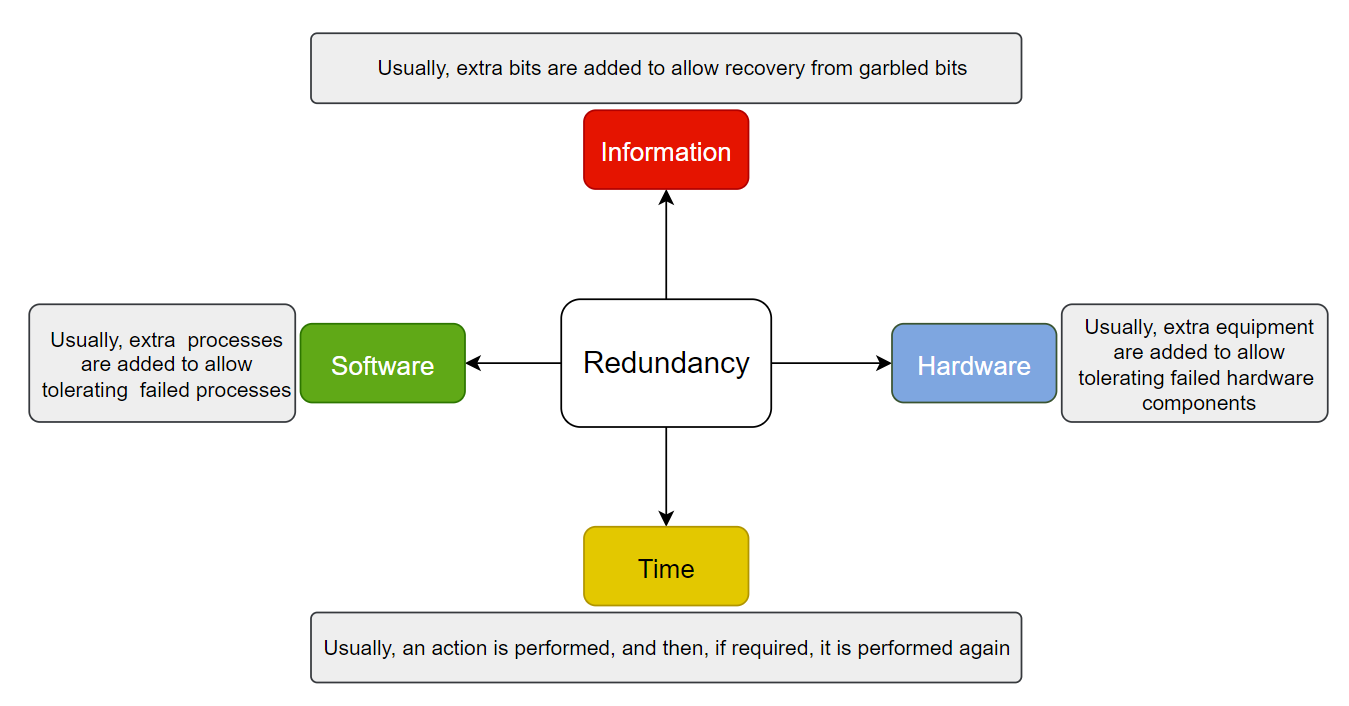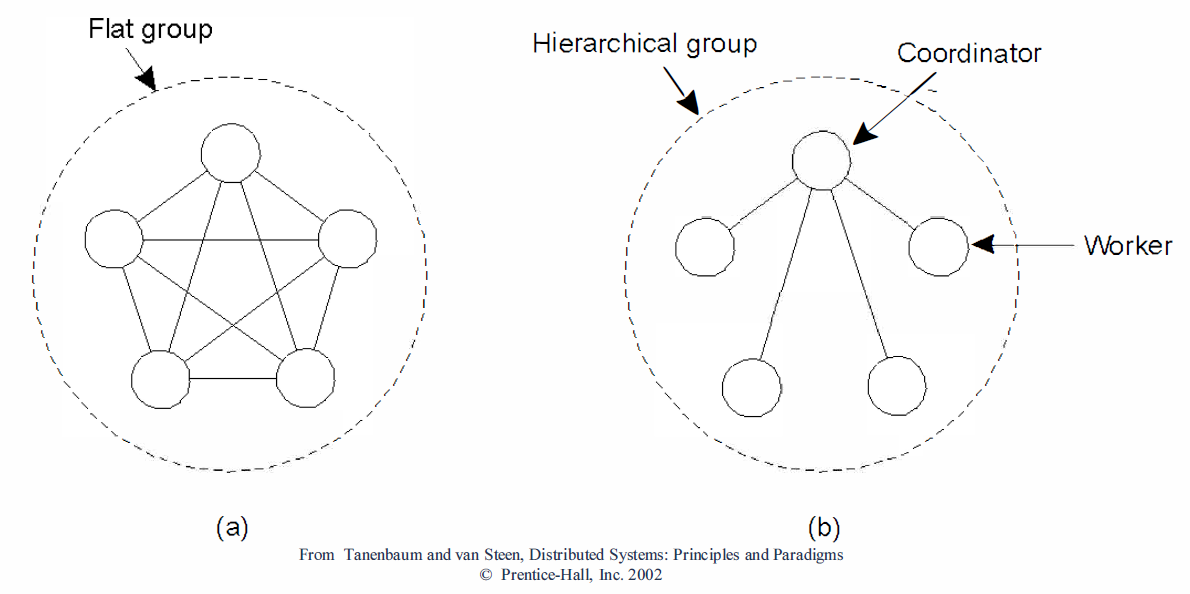Distributed System - Important Topics - Part 4
ReplicationPermalink
- It is the process of maintaining the data at multiple computers.
- Necessary for
- Improving performance
- Increasing the availability of services
- Enhancing the scalability of systems
- Securing against malicious attacks
- Key issue: if there are many replicas of the same thing, how do we keep all of them up-todate? How do we maintain consistency of replicated data?
Consistency ModelsPermalink
- Data-Centric Consistency Models
- Continuous
- Sequential
- Causal
- Client-Centric Consistency Models
- Monotonic Reads
- Monotonoc Writes
- Read Your Writes
- Write Follow Reads
Data-store (Optional)Permalink

The general organization of a logical data store, physically distributed and replicated across multiple processes.
- A data store is a service that stores data, E.g., databases, file systems, web servers
- Consists of multiple servers each containing a copy of all the data items stored in the data store
- Can be read from or written to by any process in a DS.
- Reads are performed locally
- Writes are performed locally first and then propagated to remote replicas
1. Data-Centric Consistency ModelsPermalink
a. Continuous ConsistencyPermalink
-
Applications can specify tolerable inconsistencies. Three axes of inconsistencies:
- Numerical value deviation between replicas.
- Staleness deviation between replicas.
- Update operation ordering deviation.
-
These are termed as “continuous consistency ranges.”
b. Sequential ConsistencyPermalink

(a) A sequentially consistent data store. (b) A data store that is not sequentially consistent.
- A weaker consistency model, which represents a relaxation of the rules.
- It is also much easier (possible) to implement.
- All clients see all (write) operations performed in the same order:
- Assumes all operations are executed in some sequential order
- Program order is maintained (i.e., the order of writes as performed by a single process must be maintained)
- All processes see the same ordering of operations
c. Causal ConsistencyPermalink

This sequence is allowed with a causally-consistent store, but not with a sequentially consistent store.

(a) A violation of a causally-consistent store. (b) A correct sequence of events in a causally-consistent store.
- Weaker than sequential consistency
- Two operations are causally related if:
- A read is followed by a write in the same client
- A write of a data item is followed by a read of that data item in any client
- Writes that are potentially causally related must be seen by all processes in the same order.
- Concurrent writes may be seen in a different order on different machines (i.e., by different processes as long as program order is respected).
2. Client-Centric Consistency ModelsPermalink
-
Client-centric consistency provides guarantees for a single client for its accesses to a data-store

The read operations performed by a single process P at two different local copies of the same data store. (a) A monotonic-read consistent data store. (b) A data store that does not provide monotonic reads.
a. Monotonic reads:Permalink
-
If a process reads the value of a data item x, any successive read operation on x by that process will always return that same value or a more recent value.

The write operations performed by a single process P at two different local copies of the same data store. (a) A monotonic-write consistent data store. (b) A data store that does not provide monotonic-write consistency.
b. Monotonic writes:Permalink
-
A write operation by a process on a data item x is completed before any successive write operation on x by the same process.

(a) A data store that provides read-your-writes consistency. (b) A data store that does not.
c. Read your writes:Permalink
-
The effect of a write operation by a process on data item x will always be seen by a successive read operation on x by the same process.

(a) A writes-follow-reads consistent data store. (b) A data store that does not provide writes-follow-reads consistency.
d. Writes follow reads:Permalink
- A write operation by a process on a data item x following a previous read operation on x by the same process is guaranteed to take place on the same or more recent value of x that was read.
Reliability and Fault TolerancePermalink
DependibilityPermalink
- Fault-tolerance is related to dependability, which covers:
- Availability: Readiness for usage
- Reliability: Continuity of service delivery
- Safety: Very low probability of catastrophes
- Maintainability: How easy a failed system may be repaired.
Basic TerminologiesPermalink
- Failure: When a component is not living up to its specifications, a failure occurs.
- Error: That part of a component’s state that can lead to a failure.
- Fault: The cause of an error.
Fault — causes —> Error— results in —> Failure
Different Fault Management Techniques:Permalink
- Fault prevention: Prevent the occurrence of a fault.
- Fault tolerance: Build a component in such a way that it can meet its specifications in the presence of faults (i.e., mask the presence of faults).
- Fault removal: Reduce the presence, number, and seriousness of faults.
- Fault forecasting: Estimate the present number, future incidence, and the consequences of faults.
Failure Models/Types of FailuresPermalink

Mask Failures By RedundancyPermalink

The key technique for masking faults is to use redundancy
Hardware Redundancy
- Two computers are employed for a single application, one acting as a standby
- Very costly, but often very effective solution
- Redundancy can be planned at a finer grain
- Individual servers can be replicated
- Redundant hardware can be used for non-critical activities when no faults are present
- Redundant routes in network
Process Redundancy
- Process groups:
- All members of a group receive a message sent to the group.
- If one process fails, others can take over.
- Can be dynamic; processes can have multiple memberships.

Flat versus hierarchical groups
CAP TheoremPermalink
-
The CAP theorem states “A system can be either strongly consistent (C) or available (A) during a network partition (P)”.
- Consistency (C): A shared and replicated data item appears as a single, up-to-date copy.
- Availability (A): Updates will always be eventually executed.
- Partition-tolerance (P): The system is tolerant to the partitioning of a process group (e.g., because of a failing network).
Consensus - ConceptPermalink
- Reaching Agreement is a fundamental problem in distributed computing, e.g, mutual exclusion, leader election, totally ordered multicast, ATC system, Spaceship engine control (proceed or abort)
- There are three requirements:
- Agreement: every process must output the same value
- Validity: every value output must have been provided as the input for some process
- Termination: eventually, every process must output a value.
Variants of Consensus ProblemPermalink
- Consensus Problem (C)
- Each process proposes a value
- All processes agree on a single value
- Byzantine Generals Problem (BG)
- Process fails arbitrarily, byzantine failure
- Still processes need to agree
- Interactive Consistency (IC)
- Each process propose its value
- All processes agree on the vector
Failure DetectionPermalink
- Each process is equipped with a failure detection module.
- A process P probes another process Q for a reaction.
- If Q reacts: Q is considered to be alive (by P).
- If Q does not react within t time units: Q is suspected to have crashed.
- Observation for a synchronous system:
- A suspected crash => a known crash
Reliable Client-Server CommunicationPermalink
- A communication channel may exhibit crash, omission, timing, and arbitrary failures.
- Pont-to-point communication:
- TCP can mask omission failure, but not crash failure, where the connection is broken.
- One way to deal with it is to generate an exception, or automatically setup a new connection
- RPC (Remote Procedure Calls) semantics (behavior) in the presence of failure:
- The client is unable to locate the server.
- The request message from the client to the server is lost.
- The server crashes after receiving a request.
- The reply message from the server to the client is lost.
- The client crashes after sending a request.
- Two “easy” solutions:
- If unable to locate the server: just report back to the client.
- If the request was lost: just resend the message.
- RPC semantics: Server Crash
- Server crashes have different semantics:
- at least once: server guarantees that the RPC has been carried out at least once
- at most once: server guarantees that the RPC has been carried out at most one time
- guarantee nothing: RPC may have been carried out anywhere from zero to a large number of times.
- exactly once: executed only one time, ensuring that there are no duplicates and no lost calls (impossible to achieve)
- Server crashes have different semantics:
Checkpoint and Message LoggingPermalink
CheckpointPermalink
- Checkpoint: Each process saves its state time to time to a local stable storage
- Independent Checkpoint: Each process independently takes snapshot
- Coordinated Checkpoint: Each process takes a checkpoint after a globally coordinated action
Message LoggingPermalink
Instead of taking an (expensive) checkpoint, try to replay your (communication) behavior from the most recent checkpoint
-
store messages in a log ⇒ replay your (communication) behavior from the most recent checkpoint
-
Assumption: Assume a piecewise deterministic execution model:
- The execution of each process can be considered as a sequence of state intervals
- Each state interval starts with a nondeterministic event (e.g., message receipt)
- Execution in a state interval is deterministic
By logging non-deterministic events for later replay, a deterministic execution model is established, facilitating recovery from failures.